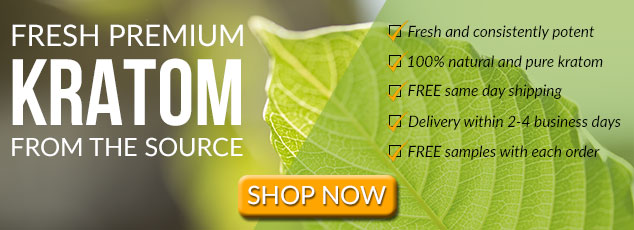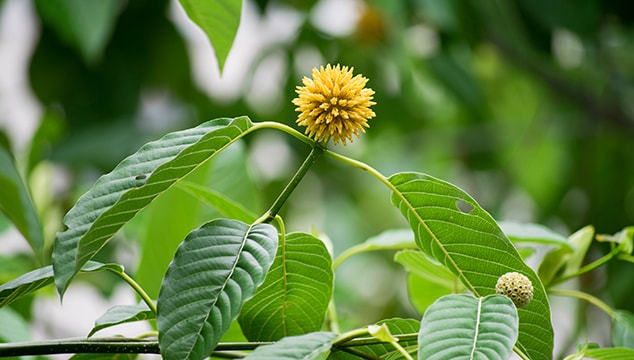You may have found a few kratom vendors offering kratom plants for sale. Fresh kratom would be nice to have. The question is – how do you grow kratom plants? And most importantly…
Can you grow a kratom plant?
Yes, indeed, you can grow a kratom plant at home. You don’t need to be a professional kratom grower, but you do need to know a few things to do that successfully.
Let’s start with the basics.
Kratom Plant Information
Kratom, or Mitragyna speciosa, plant is actually a tree. It’s indigenous to Thailand, Malaysia, Indonesia, and other Southeast Asian countries. Therefore, kratom plants thrive in a tropical environment with exposure to plenty of sunlight and humidity.
Kratom trees are evergreen. Mature trees usually reach 82 ft or 25 m in height and their trunks can be up to 3 ft (nearly 1 m) wide. Kratom leaves are dark green and have a glossy surface.
Mature leaves can be anywhere from 5 to 8 in (14-20 cm) long. That’s approximately the size of an average male hand.
Is It Legal to Grow a Kratom Plant?
In the United States laws address the use of kratom rather than growing it. That’s because growing kratom for sustainable use in the U.S would be difficult or even impossible. Kratom is a tree and needs space to grow. However, weather circumstances are not the most beneficial.
Therefore, we’d advise you to use your state laws as a guideline. If kratom is legal in your state, there should be no problem with you growing one at home. If it isn’t, we’d advise you against doing that.

How to Grow a Kratom Plant at Home?
While kratom trees aren’t hard to take care of, they are hard to propagate. There are two approaches to doing that – by using seeds and cuttings. Let’s take a look at each in more detail.
Growing Kratom Plants from Seeds
Kratom trees flower and produce pod heads filled with seeds. Each pod head contains an average of 50 seeds. Seeds are how kratom trees propagate. The quality and freshness of the seeds are paramount as it can determine whether your plants will thrive or not sprout at all.
The sooner you start germinating them, the higher your chances of getting your own kratom tree.
Choosing Kratom Seeds
If you’d like to grow kratom trees from seeds, make sure that they are fresh. By “fresh” we mean “FRESH.” These kratom seeds need to be as fresh as possible, or they’ll simply not sprout. Ideally – a few days fresh. Correction – a few days FRESH.
Therefore, first, ensure that you’re purchasing kratom seeds from a trustworthy vendor. If you don’t, you risk paying for old seeds and wasting your time trying to grow them.
Vendors from the source, that is, kratom farmers in countries where kratom is indigenous too would be ideal. However, certain risks are involved when purchasing from them. So, if you doubt or can’t trust them, don’t risk buying from them.
Secondly, use expedited shipping to ensure that the seeds get to you as soon as possible and do not spend a long time in transit or warehouses.
Finally, get seeds in bulk. Even in optimal climate, many won’t survive. The larger the amount of seeds you have, the higher your chances of getting a few kratom plants that are strong enough to grow into trees. Optimally, every 5-10 seeds should yield a plant though that’s not a guarantee.
Germinating the Seeds
To germinate the seeds, you will need nitrogen-rich soil and keep it moist. Make sure it has good drainage as you don’t want to flood your plants. It can also cause fungus, which can kill the young kratom plants.
While the seeds are germinating, they do not need much light. In natural circumstances, the soil, inside which these seeds would be, would be in the shade of the adult trees.
When you start seeing your seeds sprout, keep them in warm regulated temperature. Avoid exposing them t the cold or draught as they can die from that. Covering the plants to create a greenhouse effect can be useful for this stage.
As your kratom plants grow and develop, they become sturdier and more resilient. So, you won’t need to watch them as closely.
Growing Kratom Plants from Cuttings
An alternative option is to grow kratom plants from cuttings. A cutting is a clipping of a live plant that can be used to propagate it. In the case of kratom, you’d break off a leaf or a twig and keep it in water, moist soil, or moss until it starts growing roots. Covering them, for instance, with a plastic bag can help retain heat and moisture and, thus, help the plants grow.
This method will be much faster than growing kratom from seeds. Once the clipping has developed roots, it’ll be able to start growing new leaves. Seedlings, on the other hand, can take a few years to reach acceptable maturity. That’s when they become much easier to take care of.
It is also when farmers can practice grafting and work on new varieties of Mitragyna speciosa.
Make sure to keep an eye on your cuttings though. Heat and moisture are good for budding kratom plants. However, it’s also an excellent environment for mold and fungus, which can easily kill your fragile plants.

Which Method Should You Choose?
Honestly, none. Unless you are willing to invest a decent amount of time and effort into figuring out how to properly grow kratom plants, growing a kratom tree from the start may not be worth it. You would either need quick access to freshly harvested kratom seeds of getting your hands on a kratom plant to get a few cuttings.
Nonetheless, that does not mean that you can’t have your own kratom tree. The highest chances of you getting a kratom plant that survives are to buy a fully rooted kratom tree from trusted vendors in the United States.
To produce them, vendors keep mother trees which they make cuttings from. Then, they take care of propagating them. Once the new plants are fully rooted and approximately 8-12 inches tall, they offer them for sale. Sometimes, you may even get detailed instructions along with your plant on how to provide the best circumstances for it to thrive.
Additional Tips on How to Grow a Kratom Plant
Once you have a kratom plant that’s fully rooted and healthy, it becomes relatively easy to take care of. However, you should always keep in mind that it’s a tropical plant and needs certain conditions to grow optimally.
Below are a few tips which can help you be a happy owner of a happy kratom plant or a few:
- Keep the soil moist. Once your plant has fully rooted, it won’t need much drainage. It’s generally hard to overwater it. Yet, try not to flood it either as too much water can cause it to rot.
- If you live in a location that has an arid climate, you may want to invest in a humidifier. That will be able to provide the humidity of a tropical rainforest that kratom loves.
- Provide plenty of light. Both natural and artificial light can work. If possible invest in High-Intensity Discharge lamps or bulbs. Farmers growing indoor crops typically use these. They dissipate light differently from regular bulbs and provide better conditions for kratom plants. Keep in mind that you should put them quite high up as they may be too intense for your plant.
- Kratom plants can grow rather tall, so make sure you have a proper space for it.
- Prune your tree regularly. “This will encourage it to grow in a bushy structure rather than tall. Thus, you’ll have an easier time keeping the tree indoors.
- Kratom plants need their nutrients. Therefore, make sure the soil is nitrogen-rich and fertilize it regularly.
- Keep bugs away from your tree. You shouldn’t use any pesticides or harsh chemicals. If you plan to use the leaves, you’ll end up consuming all that. A great natural alternative is neem oil. Bugs hate it, but it’s practically non-toxic to humans, mammals, and birds
- Provide ventilation. According to some kratom farmers, wind, even artificial from a fan, helps to produce stronger kratom plants.
- Your plant doesn’t need light all day long. Do your best to mimic the tropical environment that kratom loves. However, there are nights in Thailand, Indonesia, and other Southeast Asian counties. So, you should turn off the lamps at night and, if necessary, use another source of heat instead.
When Can You Harvest?
We know, we know, you’re eager to reap the results of your hard work.
It’s best to harvest kratom leaves when your tree is close to full maturity. That can take about five years. This will yield a higher concentration on alkaloids. However, you do not need to wait for your tree to flower. Your plant will be able to develop alkaloids regardless.
Since the potency of kratom alkaloids depends on external circumstances, harvesting in late fall may be best to yield stronger leaves. You can use both fresh and dried kratom leaves, though the effects you get may differ.
Are you ready to try growing your own kratom tree? Perhaps you’ve already tried? Or maybe you are a kratom farmer who knows tips and tricks on how to grow healthy and happy kratom plants? We’d love to hear from you in the comment section below.


Leave a Reply